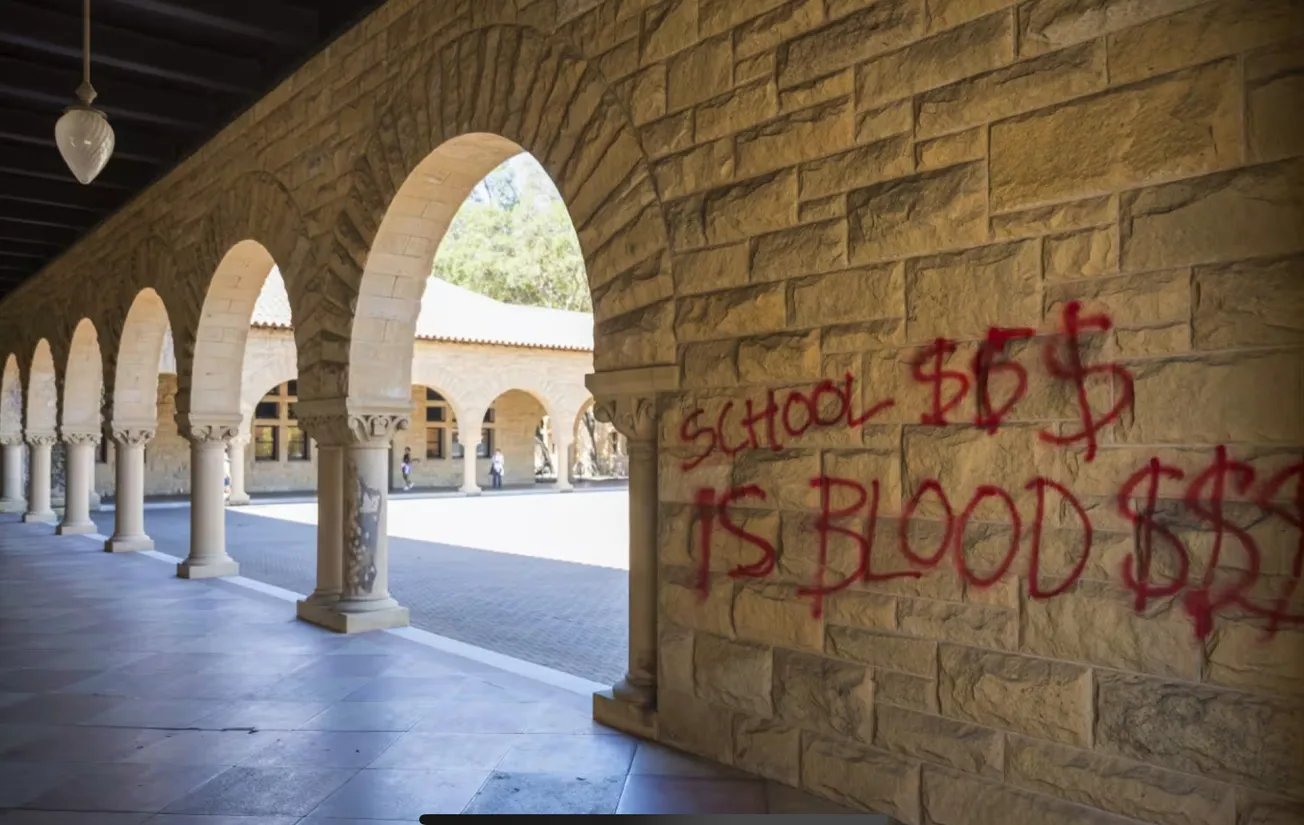Table of Contents
Call the events of Wednesday, June 5th at Stanford what you will—“shameful,” “abhorrent,” and “pathetic” are good adjectives—but do not call it “shocking.” Something can be significant without being a surprise.
Last week’s paltry riot was not startling; it was utterly predictable. The University may not have sanctioned the defacement of Main Quad or the burglary of the president’s office, but its prior actions made the rampage possible, even likely. Because moral agency exists, blame for the damage should land squarely on the vandals. The administration, however, deserves our equal contempt.
Let us review what happened: Early last Wednesday morning, a group of anti-Israel (and anti-America) students gathered in Main Quad, the oldest structure on Stanford’s campus. Armed with spray paint, they thoroughly defaced the site with soaring rhetoric such as “Pigs Taste Best Dead” and “Death 2 America.” Some of them assaulted and injured a security officer who attempted to defend a vehicle. The demonstrators then broke into the office of the university president and barricaded themselves inside before causing “extensive damage.” Thirteen students were eventually arrested, charged with felony burglary, and suspended. One has to wonder: What sort of behavior would merit expulsion?
This ordeal was the logical outcome of Stanford’s serial feebleness in response to disorder for the past year. Dereliction of duty began in October, when student protesters established a “Sit-In to Stop Genocide” in White Plaza—without approval—to make demands of the administration. At that point, the University had every ability to remove their tents and suspend anyone who refused to leave. Instead, Stanford allowed the sit-in to stay seated for four months, deconstructing it only after negotiations with organizers who never held any actual power.
Lo and behold, after facing no consequences for violating university rules, protesters erected a far larger encampment in April. Once again, Stanford could have suspended the campers on the spot and taken down their tents. But the University, once again, chose weakness. It issued occupiers flaccid warnings of vague punishment, and then left them to their business. Protesters’ names were referred to an opaque disciplinary process, but in Stanford’s words, the school “allowed the encampment to remain.”
Broken windows theory posits that “visible signs of disorder and misbehavior in an environment encourage further disorder and misbehavior, leading to serious crimes.” That theory was corroborated on May 20th, when a band of demonstrators marched into a mechanical engineering building and attempted to barricade the entrances as students were working inside. Had they been successful, the trespassers would have effectively taken their classmates hostage. Protesters were handed instant suspensions for their dangerous intrusion (Again, what exactly would earn an expulsion?). Too little too late, it turns out. The damage to Stanford’s credibility was already done.
The saying goes, “If at first you don’t succeed, try, try again.” So, the anti-Israel hooligans tried again to capture a university building last Wednesday, successfully seizing the president’s office and forcing police to tear them out with a crowbar.
Everyone should now ask Stanford the same question: What did you expect would happen? The University spent half a year letting protesters conquer portions of campus without consequence. Did the administration really believe they could get through final exams without one last burst of chaos? Through graduation? Where was the line in the sand? And what was deterring protesters from stomping over it?
Spare the excuses. Immediate suspensions of violators were always possible, as the last week has proven. Stanford pretended for months that it could not remove the encampment, yet it just did so in mere hours. The administration could have enforced the rule of law from the beginning; instead, they let it unravel.
Contrary to Rousseauian delusion, human beings are not naturally law-abiding creatures tainted only by nefarious institutions. Thomas Hobbes understood that rational individuals will act in their self-interest until the costs of doing so outweigh the benefits. If lawlessness gratifies the perpetrator—in this case, with the catharsis of throwing a fit—and comes at little cost, it will proliferate. Thus, civil society rests upon the certainty, upheld by constant enforcement, that crime will be met with retribution.
We ought to be appalled by the mayhem in Main Quad, but no one should be surprised that unenforced rules do not restrain anyone. The University led students to believe they had an inalienable right to an elite education, watched them blatantly violate school policy for months, and imposed no punishment. To paraphrase H.L. Mencken, Stanford has gotten what it deserves, “good and hard.”





